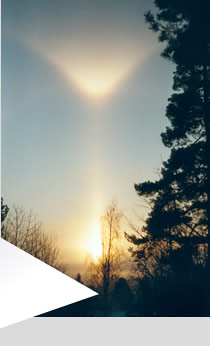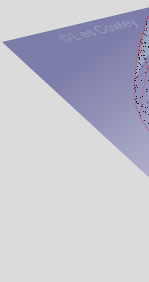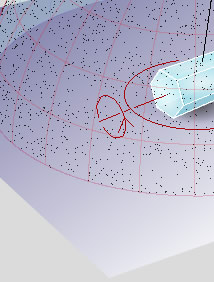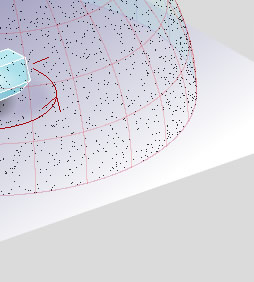|
How can horizontal column crystals make pillars? Pillars are created
by reflections from approximately horizontal crystal faces but the side
faces of columns are inclined at all angles.
The key is that the crystals have orderly orientations - they
do not tumble. A 'singly oriented column' drifts with its long axis
nearly horizontal and has two rotational freedoms. (1) Its long axis
can point in all azimuthal, NSEW, directions as indicated by the large
arrowed red circle. (2) The crystal adopts all rotational positions
around the long axis as shown by the smaller red circle.
Let's look at the resulting tilt directions of a single side face.
These are most easily illustrated by the black arrow, the "normal
vector", which points in a direction perpendicular to the face.
Imagine the crystal fixed at one azimuthal angle, say pointing east,
and rotating around its long axis. The normal vector's tip sweeps along
a line of longitude and passes through the zenith. Other azimuthal orientations
similarly cause the vector to sweep along lines of longitude and always
through the zenith. The zenith is a preferred normal vector direction.
That is, the face spends more time nearly horizontal!
We can explore the vector tip positions by computer simulation. Choose
a random azimuth, combine it with another randomly generated rotational
position about the crystal long axis and plot the resulting tip position
as a black dot on the sky sphere. The figure shows 10,000 dots generated
this way.
Each slice of latitude (altitude) contains the same number of dots
but the area of the slices decreases dramatically towards the zenith.
The dots concentrate at the zenith, they are not evenly distributed
over the sky. In other words, side faces spend more time nearly horizontal
than tilted at other angles. And near horizontal faces make sun pillars!
To summarise, the combination of two constrained
crystal rotations cause an arrow perpendicular to a side face to spend
more time pointing near to the zenith than elsewhere. This means that
side faces are therefore more often nearly horizontal than tilted at
other inclinations. Nearly horizontal faces produce sun pillars and
so, counter intuitively, column crystals generate pillars.
|









